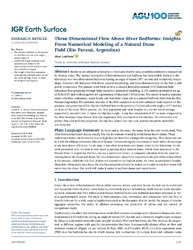Three-Dimensional Flow Above River Bedforms: Insights From Numerical Modeling of a Natural Dune Field (Río Paraná, Argentina)
DOI: https://doi.org/10.1029/2018JF004928
Persistent URL: http://resolver.sub.uni-goettingen.de/purl?gldocs-11858/9303
Persistent URL: http://resolver.sub.uni-goettingen.de/purl?gldocs-11858/9303
Lefebvre, Alice, 2019: Three-Dimensional Flow Above River Bedforms: Insights From Numerical Modeling of a Natural Dune Field (Río Paraná, Argentina). In: Journal of Geophysical Research: Earth Surface, Band 124, 8: 2241 - 2264, DOI: 10.1029/2018JF004928.
 |
View/
|
Bedforms are ubiquitous features in rivers and shallow seas, as mobile sediment is transported by flowing water. The mutual interaction of hydrodynamics and bedform has been widely studied in the laboratory over two-dimensional bedforms having an angle-of-repose (30°) lee side and a relatively simple shape. However, the influence of bedform natural morphology and three-dimensionality on the flow is still poorly constrained. The present work looks at how a natural three-dimensional (3-D) bedform field influences flow properties through high-resolution numerical modeling. A 3-D numerical model is set up with Delft3D and verified against lab experiments of idealized 3-D bedforms. The model is used to simulate water velocities, turbulence, water levels, and bed shear stress above a natural bedform field from the Río Paraná (Argentina). The presence and size of the flow separation zone and turbulent wake depend on the presence and properties of the slip face (defined here as the portion of the lee side with angles >15°) and not on those of the crest. When present, the flow separation and wake lengths are, for the tested settings, respectively, around 5 and 13 times the slip face height. A slip face orientation of 25° or more compared to the flow increases cross-stream flow and suppresses flow reversal over the slip face. To understand and predict flow and bedform properties, the slip face rather than the crest position should be identified and analyzed.
Statistik:
View StatisticsCollection
- Geologie [931]
This is an open access article under the terms of the Creative Commons Attribution-NonCommercial License, which permits use, distribution and reproduction in any medium, provided the original work is properly cited and is not used for commercial purposes.

